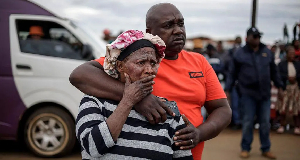Twumwusu (E/R), Sept. 6, GNA - There were at least 15,394,571 diseased cocoa trees in the Eastern Region as at the end of last year. Of these, 879,771 have been removed, as part of measures to check the spread of the Swollen Shoot Virus Disease that is devastating large areas of cocoa and threatening the industry that has been the backbone of the national economy for decades. In the Kade cocoa district alone, 1,310,446 cocoa trees have been identified as diseased as at the end of July this year, following a survey conducted on cocoa farms. This was after the cutting down and uprooting of 52,567 of those affected by the Swollen Shoot Virus. At one of such cocoa farmers education rallies at Twumwusu, the Kade District Cocoa Officer, Mr Ebenezer Agyen, emphasized that the unit would engage local labour to cut and uproot diseased trees on their farms. The Swollen Shoot Virus Control Unit (SSVCU) of the Ghana Cocoa Marketing Board (COCOBOD) is waging a relentless war on the disease and is asking for the cooperation of cocoa farmers to make the campaign succeed in order to save the "golden pod". The SSVCU in the Kade Cocoa District is conducting a sustained campaign by taking the message to all cocoa growing areas on the need to identify diseased trees and promptly getting the unit informed to immediately act to cut and uproot them to save nearby farms and check the spread of the disease.
They should therefore co-operate with the control unit and not hide the fact that they had diseased trees on their farms. Cocoa farmers who co-operate, he told them would have no regrets what so ever since they would be given adequate compensation for the lost trees and given further financial incentive if they replant. Mr Agyen regretted that the disease was spreading because of opposition from farmers. Mr Robert Akuffo-Larbi, Chief Technical Assistant, spoke on quality control, farm sanitation and management and correct fertilizer application. He said proper maintenance of farms improved production and noted that it was necessary to properly ferment and dry the cocoa beans in order to do away with purple beans. It was also essential to store dried cocoa beans in jute sacks supplied or approved by COCOBOD. Mr E. D. Ofori, Chief Cartographic draughtsman, warned against use of child labour on cocoa farms and advised parents to send their children to school.
Regional News of Saturday, 6 September 2008
Source: GNA












